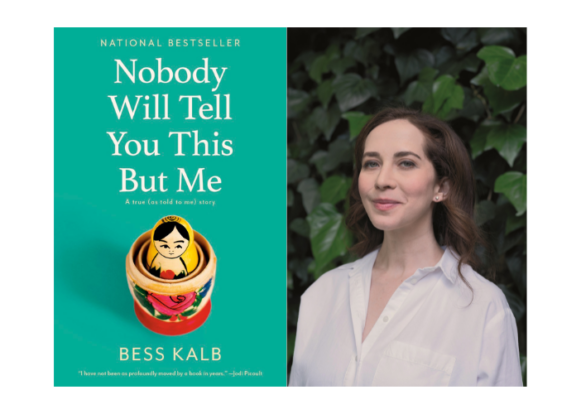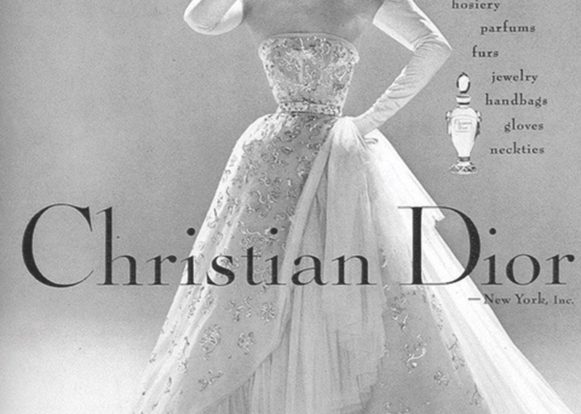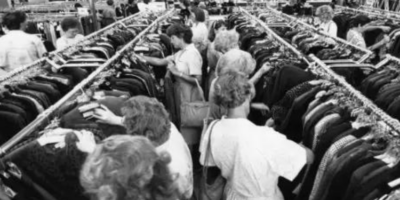Lilith Feature
Shopping: A Eulogy
RETAIL: AN INTRODUCTION
Picture, if you still can, the packed dressing room of a Loehmann’s, in the days before that deep-discount clothing emporium, its stores for decades a New York shopping icon, shuttered its doors. The lighting is grey, fluorescent, unflattering. But never mind, it signifies the business at hand: the sacred and profane ritual of communal shopping.
Hooks and clothing racks line the dressing-room walls, but the focal point of the space is a wall-to-wall, floor-to-ceiling mirror, reflecting dozens of pirouetting, preening bodies. Women. Women of all shapes, colors, sizes and ages, cellulite visible, in various states of undress: pulling their legs through pants, shimmying the fabric of dresses down over their hips. They are talking to each other (even to strangers) as they don their apparel: “Mom, that looks great on you!” “Too roomy, honey.” “Does it come in another color?”
This scene, once so common, marked by its fleshiness, its commingled breath, its total lack of privacy, and its awkwardness, is the quintessential pre-pandemic shopping memory. It’s as far from today’s click, order, then-snap-a-selfie process for purchasing clothes as one can imagine. Perhaps the intimacy of it all, even the overbearing qualities of that intimacy, may draw out a surprising yearning in those who recall it. Because now it’s not just Loehmann’s we mourn, but the fact that we cannot gather in that way, or any way, for a long time, or maybe ever.
Loehmann’s was one of the victims of the pre-Covid-19 “retail apocalypse” that was in full force even before the pandemic hit, a sign of our further march into late-stage capitalism, in which even the leisure of a quick in-person browse was becoming too leisurely for most time-strapped consumers. Thus for many of us, each chain that closes or is diminished— Lord & Taylor’s flagship store, Loehmann’s, Sears, J. Crew, Neiman Marcus — is not merely another famous brand name shuttering its doors, or retrenching. It’s a relic of another time, with memories that transcend clothes.
Stores-as-destinations, from upscale boutiques to a hip thrift store, provided communal spaces where women could be together, learn from each other and participate in an intimate treasure hunt. Spaces where our mothers and aunts and grandmas transmitted to us their concept of taste, of body image (for better and often for worse), of what kind of woman they wanted us to be.
So what will we do now?
Well, it’s complicated. Because the death of retail isn’t just the story of a lost way of life. And there are threads of hope in the fabric of this ruin: think of the hand-sewed masks or the way new companies are blasting “handmade in the USA” on ads across the internet. Think of all of us, as lockdown and distancing marched on, stepping back from consumerism as a form of cheap therapy.
Indeed, as we look at what clothes and shopping might be in the future, it’s not all loss and alienation. As those dozens of homemade, hand-sewn masks on Etsy show us, our current moment allows us a new intimacy with the people who make things for us—our friends or friends of friends with sewing machines and patterns or factory workers whose locations and incomes we are aware of—that could signal a new balance when the pandemic dust settles.
“The shutdown is forcing a rethinking of production and consumption within the fashion industry, and it’s unfortunate that it took this long for these structures to self-examine,” says Julianne Escobedo Shepherd, the editor-in-chief of Jezebel and a longtime fashion industry reporter. “For years, luxury fashion has forced designers to produce to an increasingly impossible schedule, siphoning creativity and creating a surplus that dictates the speed and urgency of more affordable fast fashion outlets to replicate it. It’s long been time for fashion to slow down. This schedule is simply unsustainable, from the higher-end fashion designers to the workers, often in inhumane sweatshop conditions, who produce cheap replicas.”
Shopping, like everything else we’re mourning in this strange suspended moment, may never be the same. Can we be appropriately mournful of what we’ve lost—the touch of fabric, the self-inspection in store mirrors—while looking to a future of consumption that is fairer and more thoughtful than that recent past?
MOTHERS AND DAUGHTERS
“The department stores, which have been failing slowly for a very long time, really don’t get over this,” Mark A. Cohen, the director of retail studies at Columbia University’s Business School, told the New York Times this spring, as the shock of pandemic settled in. “The genre is toast, and looking at the other side of this, there are very few who are likely to survive.”
Alexanders. Marshalls. A&S. Macy’s. B. Altman. The May Co. in Ohio, Donaldson’s in Minnesota and more. Just mentioning any of these names brings up stories for so many: often about mothers and daughters, or grandmothers, or girlfriends. Personally, each name has a new flavor for my New York-bred self: I recall the stately Lord & Taylor flagship, where my entire family used to go for the annual sale, or fancy Henri Bendel, an impossibly trendy outpost where my teenage friends and I begged salespeople for perfume samples. And then the thrift stores in Greenwich Village where generations of teens (including mine) tried on flared jeans and polyester shirts, experimenting with gender and social presentations. All these memories are so deeply tactile, marked by careful sorting, touching products, even if we didn’t buy.
Rites of passage and important occasions have long been marked (for those who could afford it) by the ritual of buying clothes together, with other women who would join together to get the bat mitzvah dress, the prom dress, the wedding dress. Nice new shoes for the beginning of the school year (will those ever happen again?) or a blazer for a first job interview. The shopping was often bookmarked with lunch. It was a tuna melt and tomato soup for me and my mom.
“My grandmother and I had a ritual of going to A&S department store in downtown Brooklyn, shopping together for an outfit and then heading over to Junior’s to split a sandwich and have cheesecake. We usually did this on Labor Day Weekend,” says Aileen Weintraub. A fancy lunch in the department store’s own restaurant was often an extra-special treat. Catchphrases might be coined on these trips: Alix Wall recalls her grandmother saying “it would be a crime to leave it in the store” when she came across a bargain at Alexander’s in Paramus, New Jersey.
Sometimes our memories were more mixed. Judy Bolton-Fasman associates Lord & Taylor with “revenge shopping,” a trip her mother took after a quarrel with her dad, spending money to strike back at perceived injustice and then hiding the results in the back of the closet. But still, she says, it was a way of learning about her mother’s “aspiration to a better life,” the store symbolizing “the epicenter of polite humanity.”
In a moving tribute to shuttering department stores, writer Andrea Atkins describes the trips she took with her mother to these palaces of consumerism. “In the department store, my mom inculcated in me her sense of taste, decorum, and style… her values, financial sense, restraint, and sometimes, determination,” she wrote at the website Next Tribe. “I learned what she yearned for.”
Sometimes the brand name or the store itself didn’t matter: it was the physicality of the experience itself. Boutiques and thrift stores, now also in deep danger, were about curatorial fashion, the store as an expression of identity and ingenuity.
Shoe stores for growing children had a tactile value, too: “I think often of shoe shopping with my mom as a kid and her pressing on the toe to see how much room to go I had,” says Courtney Stephens. “That feeling of being given space to expand into, in this very functional way.”
JEWS INTERTWINED WITH FASHION
None of these experiences are unique to Jews, or to women, or to Jewish women—there are certainly equivalent male rituals like the bar mitzvah suit and quinceanera dresses, communion outfits and garb for other non-Jewish rituals that make shopping trips sacred for many groups.
And yet history shows us that Jews and fashion in America have been intertwined on every level: from the women and girls trapped in the Triangle Shirtwaist fire, to the garment workers who organized in that tragedy’s aftermath, to the stereotype of the shopping-bag-laden so-called Jewish American Princess, deconstructed from time to time in Lilith’s pages.
“As early as 1890 almost 80 percent of New York’s garment industry was located below 14th Street, and more than 90 percent of these factories were owned by German Jews,” according to A History of Jews in America, condensed at MyJewishLearning.com. More numbers follow: “Immigrants were attracted by jobs and by Jewish employers who could provide a familiar milieu as well as the opportunity to observe the Sabbath. By 1897 approximately 60 percent of the New York Jewish labor force was employed in the apparel field, and 75 percent of the workers in the industry were Jewish.”
It goes on: “In 1880, 10 percent of the clothing factories in the United States were in New York City; by 1910 the total had risen to 47 percent, with Jews constituting 80 percent of the hat and cap makers, 75 percent of the furriers, 68 percent of the tailors, and 60 percent of the milliners.”
Some of the biggest names in the department store world were Jewish: from the venerable and frighteningly posh Bergdorf Goodman to A&S’s Abraham & Strauss, Gimbel’s, Filene’s and Kohl’s, to name just a few. Many of these dynasties began with peddlers, tradespeople or shopkeepers who vaulted into the “rag trade” big time.
But if women got a foothold on the power ladder as fashion buyers for these stores, and on their sales floors, the dynasties were largely male. The beloved television drama “Mad Men” even referenced this, by creating cult-favorite character Rachel Menken, the Jewish daughter of a department-store dynasty who wanted to take charge of the business and was met with skepticism and sexism by the goyishe men in the advertising industry, not to mention her own family.
And on the other end of these growing industries it was women who were at the sewing machines. In the early days of Jewish immigration to America, sweatshops crammed Jewish women, men and even children together on the Lower East Side and elsewhere. Jewish women counted heavily among the tragic, neglected 146 workers dead in the notorious Triangle Shirtwaist Fire in 1911, which drew national attention to inhuman conditions in sweatshops and factories.
In its wake, the famous Uprising of the 20,000—the New York Shirtwaist workers strike of 1909—became one of the flash points of Jewish feminism, socialist feminism and labor organizers in general. Led by Jewish communist firebrands Rose Schneiderman and Clara Lemlich, the successful strike changed the garment industry in America.
Yet it’s hard to ignore the fact that while some American women, Jewish women among them, moved from the sewing machine to positions in front of and behind the sales counter, the stitching labor itself didn’t disappear; the women wielding needles, doing piecework in factories, simply moved elsewhere. In the 1990s, the ascendant students-against-sweatshops movement drew Jewish students into activism. They called attention to the overseas labor practices of companies like Nike, and more, enabled by new “Free Trade” agreements. I spent a summer leafleting on 57th street, warning consumers that entering the Niketown store was tantamount to abetting oppression, even slavery.
We learned that the people suffering under these conditions were mostly women, sewing monotonously, locked in, discriminated against if they got pregnant, denied bathroom breaks—100 years after the Triangle Shirtwaist fire and the changes it wrought in U.S. fair-labor laws.
For me, it is hard to reconcile the very human love of fabric, of shopping, of seeking out communal space, with the exploitation behind it. My generation of feminists seized onto the words of second-wave critic Ellen Willis, reminding us that shopping, for women in a sexist world, can’t be criticized as mere empty consumerism. “When a woman spends a lot of money and time decorating her home or herself… it is not idle self-indulgence (let alone the result of psychic manipulation) but a healthy attempt to find outlets for her creative energies within her circumscribed role,” she wrote. “Consumerism as applied to women is blatantly sexist…. When we create a political alternative to sexism, racism, and capitalism, the consumer problem, if it is a problem, will take care of itself.”
ALIENATION AND COMMUNITY
Willis was well-versed in Marxist theory, which—and here I’ll be reductive—posits that the further we are swallowed into capitalism’s maw, the deeper our alienation: alienation from the products of our own labor, from our fellow workers, and ourselves, our essence. If the shopping trips that marked American middle-class life since WWII epitomized that alienation in a sense (we were alienated from the menial sweatshop work that went into making our clothes), we were also connected to each other through these rituals. As capitalism continued to accelerate, the problem continued to grow worse. At department stores, American-made clothes with the honorable UNITE! Union Label, which my mom had taught me to seek out on our shopping trips, grew harder to find.
“Fast fashion”—cheaper, more ubiquitous, more disposable—became the norm, and the old chains started to fail. For today’s shoppers, the move from the home-like spaces of department stores and boutiques to using computer keyboards and Paypal, and buying ever-cheaper “athleisure,” like stretchy leggings, to self-soothe takes us even further down that path, alienating us from physical joining together.
Once or twice, on shopping trips that had become rarer and were less and less pleasant, I found myself musing on the change. My recollection was of the department store as a space, as a sort of semi-private, semi-public commons. As a child, I used to sit on the floor happily under clothing racks while my mom looked for deals. As a teen and young adult, I found in department stores a place of refuge, with their expansive ladies’ rooms that contained couches and countertops for makeup application, their benches in the dressing rooms and scattered throughout the floor. Of course, finding such a refuge was contingent on race and class status, but if you could find it, it was heaven. During a bad period at an old job I used to slink off at lunchtime to the Macy’s shoe department, where I could stand amidst racks of discounted high heels I’d never wear and take a deep breath or call a friend or my mom for solace.
But those days are gone: even the department stores that remain are slick, expensive, with few benches and no nooks or crannies for hiding. Like other, homey spaces New York was already chasing out—dive bars and diners and gritty music venues—they were losing the battle.
Online shopping had arrived. “One of the major issues with online shopping is that it’s easier for anyone to procure clothing produced under inhumane conditions, without much knowledge about how the garments are made,” says Escobedo Shepherd. “Inexpensive, trendy clothing is a huge boon for people in lower income brackets who want and deserve to be as fashionable as their wealthier counterparts, but the whole system—from a high-end label’s eight or ten seasons per year on down—contributes to inequity across the board, not to mention is environmentally destructive.”
Understanding the exploitation behind fashion had already made my genuine nostalgia arrive with a chaser of queasiness. With climate change on the horizon and more and more reports of exploitation abroad, impulse shopping for me had been getting more and more fraught before Covid-19. (I was still doing it, just with more guilt.)
The devastating 2012 Dhaka factory fire, at a sweatshop in Bangladesh, reminded me so much of the Triangle Fire. It was followed a year later by another catastrophe with a toll: a factory collapse that killed even more workers. This marked the end of my flirtation with fast-fashion chains like H&M. I continued hunting for deals so good “you can’t afford not to buy,” to quote my grandmother and yours, at discount retailers like Marshalls and TJ Maxx, justifying the fact that these were trendy pieces from a few years back that would float around or be trashed if they weren’t re-sold.
Yet beyond that, I had made an even more stringent effort to change my own habits, beginning mostly to patronize three or four online shops that claimed to be eco-friendly, ethical and, ideally, made domestically (some even showing photographs of the dressmakers) allowing me to rely far less on sweatshops that oppress other women and more on clothing whose sources and resources I knew—or thought I did. Transparency and small-batch sewing are the new trends in fashion, and this may be a step forward, but maybe a step back if you think of Ellen Willis. It seems to be linked, at least on Instagram, with a mom-perfectionist lifestyle: an almost performative level of concern about the purity of the products you and your kids consume.
And yet the benefits of these small, direct-to-consumer companies go beyond the supply chain: for gender-noncomforming people, for those who were shamed for their size, for disabled folks, many of these shopping rituals I remember fondly carried pain and exclusion. Online boutiques and companies have been popping up to serve niche groups that wouldn’t necessarily have found a home in a department store.
Now with the pandemic, many of us are shopping for masks for our families. I’ve tried to buy American-made, organic cotton masks, or shopping directly from women artisans on Etsy, recommended by friends who are using their hands to create clothes for us. But no change comes without its cost: “There are more sustainable, popular, recycled/vintage platforms like Depop and Etsy that cut down a bit on this process, though there’s still mail waste (and warehouse and mail worker exploitation!) to consider,” says Escobedo Shepherd.
In the “someday” many of us dream about, will we recreate spaces to wander, to touch the garments we’re considering? Or will we continue down the road we’re on, away from in-person shopping? Will we wear outrageous clothing on the street [see sidebar] or will homespun become a trend again? I know that I will dearly miss the feel of fabric between my hands, the click of hangers as I push them aside to look for the diamond in the rough. But I don’t think I will ever be able to participate in those rituals again without wanting even more of a connection that I once had: not just a connection to the people I’m shopping with and for, but also a connection with and understanding of who made the items I’m touching.
In This Feature
Bess Kalb
“I Never Saw My Mother in a Clothing Store”The comedian channels her grandmother’s tale of family and footwear.







